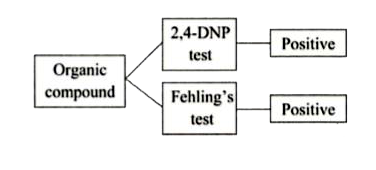Mention the uses of (i) formaldehyde (ii) urotropine (iii) acetaldehyde (iv) acetone
(v) benzaldehyde (vi) cetophenone and benzophenone.
Formaldehyde :
(i) 40% aqueous solution of formaldehyde is called formalin. It is used for preserving biological specimens.
(ii) Formalin has hardening effect, hence it is used for tanning.
(iii) Formalin is used in the production of termo setting plastic known as bakelite, which is obtained by heating phenol with formalin.
Urotropine :
(i) Urotropine :
(i) Urotropine is used as a medicine to treat urinary infection.
(ii) Nitration of Urotropine under controlled condition gives an explosive RDX (Research and development explosive).
It is also cyclonite or cyclotri methylene trinitramine.
Acetaldehye :
(i) Acetaldehyde is used for silvering of mirrors.
(ii) Paraldehyde is used in medicine as a hypnotic.
(iii) Acetaldehyde is used in the commerical preparation of number of organic compound like acetic acid, ethyl acetate etc.,
Acetone :
(i) Acetone is used as a solvent,in the manufacture of smokeless power (cordite).
(ii) It is used as a nail polish remover.
(iii) It is used in the preparation of sulphonal, a hypnotic.
(iv) It is used in the manufacture of thermosoftening plastic Perspex.
Benzaldehyde is used :
(i) as a flavoring agent
(ii) in perfumes
(iii) in dye intermediates
(iv) as starting meterial for the synthesis of serveral other organic compounds like cinnamaldehyde, cinnamic acid, benzoyl chloride etc.
Aromatic Ketones :
(i) Acetophenone has been used in perfumery and as a hyphotic under the name hyphone. (ii) Benzophenone is used in perfumery and in the preparation of benzydrol drop.
Topper's Solved these Questions
- CARBONYL COMPOUNDS AND CARBOXYLIC ACIDSBOOK - PREMIERS PUBLISHERSCHAPTER - CARBONYL COMPOUNDS AND CARBOXYLIC ACIDSEXERCISE - OTHER IMORTENT QUESTIONS & ANSWERS ( CHOOSE THE CORRECT ANSWER.)
29 Videos
- BIOMOLECULESBOOK - PREMIERS PUBLISHERSCHAPTER - BIOMOLECULESEXERCISE - OTHER IMPORTANT QUESTIONS& ANSWERS (Answer the following questions)
66 Videos
- CHEMICAL KINETICS BOOK - PREMIERS PUBLISHERSCHAPTER - CHEMICAL KINETICS EXERCISE - OTHER IMPORTANT QUESTIONS & ANSWERS (II. Answer the following questions.)
52 Videos
Similar Questions
Knowledge Check
The order of reactivity of phenyl magnesium bromide with the following compound is
(I) Acetone (II) Acetaldehyde (III) Acetophenone (IV) BenzonphenoneAI>II>III>IVBII>I>III>IVCIV>III>II>IDIII>IV>I>II
How will you preform the following conversions?
(i) Acetaldehyde to acetone
(ii) Propanone to propene
(iii) Propene to propanone
(iv) Benzaldehyde to benzophenone
(v) Benzene to acetophenone
View SolutionHow will you differentiate between?
(i) Aceetaldehyde and acetone.
(ii) Aldehydes and ketones with (i) Tollens's regent (ii) Fehling's solution
(iii) Acetone and diethyl ether
(iv) Formaldehyde and acetaldehyde.
(v) Ethyl alcohol and acetone
(vi) Formaldehyde and ethyl alcohol
(vii) Pentan-2-one and pentan-3-one
(viii) Benzaldehyde and acetophenone
(ix) Benzaldehyde and acetaldehyde ltbr (x) Benzaldehyde and introbenzene.
View Solution(i) Givean industrial preparation of (a) formaldehyde, (b) acetaldehyde and (c) acetone
(ii) Give the methods by which ethyl alcohol may be converted into acetaldehyde
(iii) How is an aldehyde obtained from an acid chloride?
(iv) Write an equation for making aldehydes by the oxo process.
(v) How is impure acetaldehyde purified? ltbr (vi) How is impure acetone purified?
View Solution
How many amont the following compound will give the above result?
I. Cyclohexanone
ii. Acetone
iii. Propionaldehyde.
iv. Acetophenone.
v. Acetaldehyde
vi. Benzophenone
vii. Benzaldehyde.
View Solution
How many amont the following compound will give the above result?
I. Cyclohexanone
ii. Acetone
iii. Propionaldehyde.
iv. Acetophenone.
v. Acetaldehyde
vi. Benzophenone
vii. Benzaldehyde.
View Solution
Among the given compounds, how many will show this behaviour?
i. Cyclohexanone
ii. Acetone
iii. Propionaldehyde
iv. Acetophenone
v. Acetaldehyde
vi. Benzophenone
vii. Benzaldehyde
View SolutionPredict the product of reaction of
(I ) Acetone with aniline (ii) RCHO with hydrazine in the pressence of KOH
(iii ) formaldehyde with ammonia (iv ) Butanone with LiALH4
(v ) aldehyde with tollen's reagent (vi ) acetone with KMnO4
View Solution
